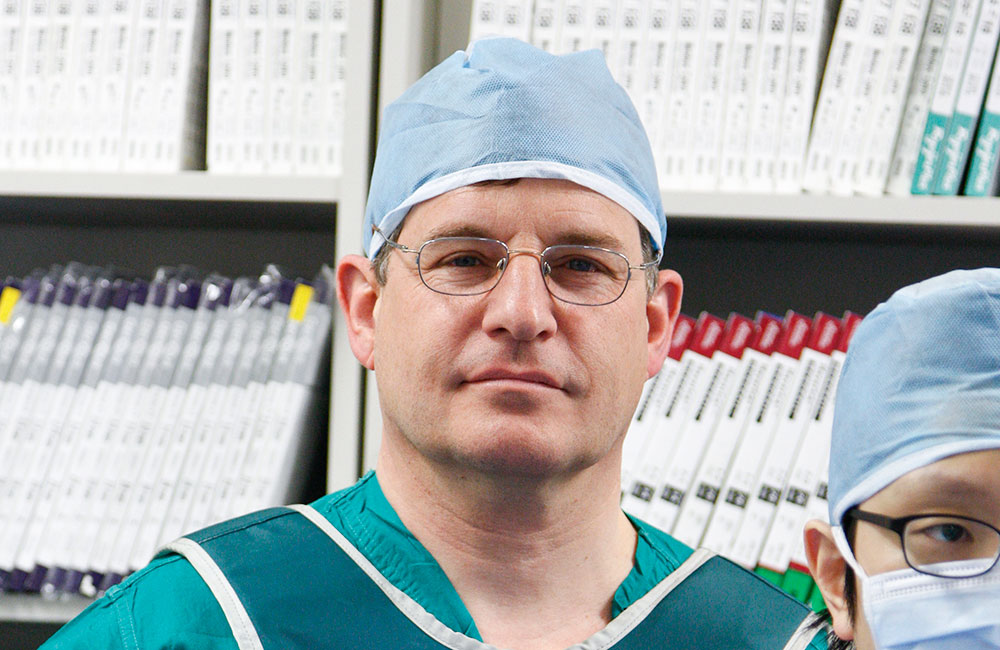
Dr. Nico Pijls
FFR, FFR!
Dr. Nico Pijls (Netherlands) is a Professor of Cardiology at Catharina Hospital in Eindhoven, Netherlands, and a Knight in the Order of the Netherlands Lion. A pioneer in interventional cardiology, he developed and advanced Fractional Flow Reserve (FFR), leading landmark studies such as DEFER and FAME, which have shaped clinical guidelines. With over 374 publications and 37,427 citations, his work has had a profound impact on cardiovascular research. FFR-guided PCI has now become the gold standard treatment for PCIs, classified as Class 1A in both ACC/AHA and ESC guidelines. He has been honored with the Andreas Grüntzig Ethica Award (2002), the title of Knight in the Order of the Netherlands Lion (2018) and the TCTAP “Master of the Masters” Award (2024).
Nico, I would like to take this opportunity at this award ceremony to thank you for this extraordinary and unique, human, and scientific adventure spanning almost 40 years. I’d like to insist on the fact that it is you who deserves the credit for crystalizing the concept of fractional flow reserve and theorizing its validity. Our magic recipe has been to collaborate openly and synergistically since day one. Nico, I hope you will have the chance to celebrate this award, with the many colleagues and friends who have joined us and have accompanied us on the journey of coronary physiology, many of whom are probably present at TCTAP. (Bernard De Bruyne) You often mention that the most valuable part of your career are the more than 20 PhD fellows that you’ve guided as a professor at a technical university here in Eindhoven. I was one of them to significant careers. But you’ve also molded these people and made them better people in their daily life. I truly believe that. And this is all recognized because of you. (Pim Tonino)
Your impact on the field of interventional cardiology has been immense. Whether it’s your early work with videodensitometry, or the derivation and validation of fractional flow reserve, or your latest work with absolute coronary flow. But to me, your true legacy is the impact that you’ve had on so many trainees and colleagues. Your generosity, collaboration, and friendship are unsurpassed. (William F. Fearon) I would like to contribute to that since I have known him a long time, and his work as the major translation from the basic experimental fluid dynamic equations into the clinical realm of applied clinical coronary pathophysiology that has moved beyond the angiogram. So, it’s a major milestone, and I’m deeply indebted to Nico and greatly honored to have great fond memories of him coming to Texas to work out the equations that are the basis of his fantastic advance. (Lance Gould) You, a cardiologist and also a biomedical engineer, invented fractional flow reserve by linking hemodynamics with coronary physiology. Through an analysis involving some 40 mathematical equations. Equally impressive, you managed to get that theory, along with its detailed validation, published into Circulation in 1993, and I am proud to have worked with you on that foundational paper. Indeed, you are a cardiology master, but you’re also a damn good engineer. Congratulations. (Richard Kirkeeide) Dear Nico, as a friend and colleague for more than 30 years, it is a great pleasure and honor to congratulate you with your truly deserved title, Master of Masters. We’ve been working closely together, and we were both satisfied with this cooperation for more than 30 years. I really hope to work with you together in the future, and I wish you all the best. (Jacques Koolen) I think you are someone who really made a difference in our cardiological interventional field. And I’m very pleased to call you, I think, a dear colleague and a friend for many, many years. Even though you are so called retired, you still take a deep interest in the science that you also shaped. But what I’m envying most is that you look the same today as when we met, maybe 25 or 30 years ago. Well, I have changed a lot and lost a lot of hair, but you never lost your enthusiasm. (Gerald Werner)
One vivid memory I have is of Nico’s attendance at our TCTAP meeting starting in 2008, even before we began using FFR at Asan Medical Center (AMC). One day, during a PCI case, I encountered an 80% proximal RCA stenosis and was about to place a stent when an observing physician asked, ‘Why aren’t you doing FFR?’ Out of curiosity, I performed FFR, which showed a value of 0.86. I was truly surprised that an 80% severe stenotic lesion had a negative FFR. Additionally, follow-up tests, including treadmill exercise, a thallium scan, and a stress echo, were all negative. After encountering this mismatched case, we began using FFR at AMC in 2009. We then conducted extensive computational simulation studies on its flow dynamics, discovering that factors such as lesion eccentricity, length, and roughness significantly influence coronary flow. Over time, through data collection (IRIS FFR registry) and research, we became firm FFR believers.
Since 2009, we have actively implemented FFR in our practice, resulting in a 40% reduction in unnecessary PCI and, believe it or not, approximately a 60% reduction in CABG surgeries. It also took a long time to convince the surgeons as well. Costs decreased, and patient outcomes improved. It took us 15 years, and 30 years from Nico’s initial concept, to fully realize its impact. Nico truly deserves the title of ‘Master of Masters,’ and I am profoundly grateful for his pioneering contributions.
Dr. Nico Pijls (Netherlands) is a Professor of Cardiology at Catharina Hospital in Eindhoven, Netherlands, and a Knight in the Order of the Netherlands Lion. A pioneer in interventional cardiology, he developed and advanced Fractional Flow Reserve (FFR), leading landmark studies such as DEFER and FAME, which have shaped clinical guidelines. With over 374 publications and 37,427 citations, his work has had a profound impact on cardiovascular research. FFR-guided PCI has now become the gold standard treatment for PCIs, classified as Class 1A in both ACC/AHA and ESC guidelines. He has been honored with the Andreas Grüntzig Ethica Award (2002), the title of Knight in the Order of the Netherlands Lion (2018) and the TCTAP “Master of the Masters” Award (2024).
Nico, I would like to take this opportunity at this award ceremony to thank you for this extraordinary and unique, human, and scientific adventure spanning almost 40 years. I’d like to insist on the fact that it is you who deserves the credit for crystalizing the concept of fractional flow reserve and theorizing its validity. Our magic recipe has been to collaborate openly and synergistically since day one. Nico, I hope you will have the chance to celebrate this award, with the many colleagues and friends who have joined us and have accompanied us on the journey of coronary physiology, many of whom are probably present at TCTAP. (Bernard De Bruyne) You often mention that the most valuable part of your career are the more than 20 PhD fellows that you’ve guided as a professor at a technical university here in Eindhoven. I was one of them to significant careers. But you’ve also molded these people and made them better people in their daily life. I truly believe that. And this is all recognized because of you. (Pim Tonino)
Your impact on the field of interventional cardiology has been immense. Whether it’s your early work with videodensitometry, or the derivation and validation of fractional flow reserve, or your latest work with absolute coronary flow. But to me, your true legacy is the impact that you’ve had on so many trainees and colleagues. Your generosity, collaboration, and friendship are unsurpassed. (William F. Fearon) I would like to contribute to that since I have known him a long time, and his work as the major translation from the basic experimental fluid dynamic equations into the clinical realm of applied clinical coronary pathophysiology that has moved beyond the angiogram. So, it’s a major milestone, and I’m deeply indebted to Nico and greatly honored to have great fond memories of him coming to Texas to work out the equations that are the basis of his fantastic advance. (Lance Gould) You, a cardiologist and also a biomedical engineer, invented fractional flow reserve by linking hemodynamics with coronary physiology. Through an analysis involving some 40 mathematical equations. Equally impressive, you managed to get that theory, along with its detailed validation, published into Circulation in 1993, and I am proud to have worked with you on that foundational paper. Indeed, you are a cardiology master, but you’re also a damn good engineer. Congratulations. (Richard Kirkeeide) Dear Nico, as a friend and colleague for more than 30 years, it is a great pleasure and honor to congratulate you with your truly deserved title, Master of Masters. We’ve been working closely together, and we were both satisfied with this cooperation for more than 30 years. I really hope to work with you together in the future, and I wish you all the best. (Jacques Koolen) I think you are someone who really made a difference in our cardiological interventional field. And I’m very pleased to call you, I think, a dear colleague and a friend for many, many years. Even though you are so called retired, you still take a deep interest in the science that you also shaped. But what I’m envying most is that you look the same today as when we met, maybe 25 or 30 years ago. Well, I have changed a lot and lost a lot of hair, but you never lost your enthusiasm. (Gerald Werner)
One vivid memory I have is of Nico’s attendance at our TCTAP meeting starting in 2008, even before we began using FFR at Asan Medical Center (AMC). One day, during a PCI case, I encountered an 80% proximal RCA stenosis and was about to place a stent when an observing physician asked, ‘Why aren’t you doing FFR?’ Out of curiosity, I performed FFR, which showed a value of 0.86. I was truly surprised that an 80% severe stenotic lesion had a negative FFR. Additionally, follow-up tests, including treadmill exercise, a thallium scan, and a stress echo, were all negative. After encountering this mismatched case, we began using FFR at AMC in 2009. We then conducted extensive computational simulation studies on its flow dynamics, discovering that factors such as lesion eccentricity, length, and roughness significantly influence coronary flow. Over time, through data collection (IRIS FFR registry) and research, we became firm FFR believers.
Since 2009, we have actively implemented FFR in our practice, resulting in a 40% reduction in unnecessary PCI and, believe it or not, approximately a 60% reduction in CABG surgeries. It also took a long time to convince the surgeons as well. Costs decreased, and patient outcomes improved. It took us 15 years, and 30 years from Nico’s initial concept, to fully realize its impact. Nico truly deserves the title of ‘Master of Masters,’ and I am profoundly grateful for his pioneering contributions.

